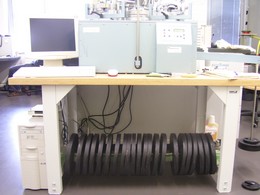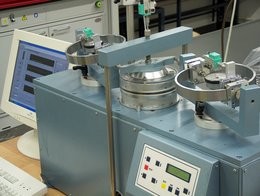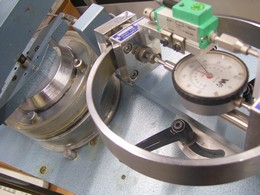Page path:
- Marine Geotechnics
- Marine Geotechnics Lab
- Ring Shear
Ring Shear
Ring shear tests on representative Strata and direct shear tests on actual slip surfaces has rarely been full developed. Since a number of studies have shown that the ring shear tests may possibly provide the lower bound strength in any investigation, this omission has been of concern. Ring shear testing could not have become a routine procedure out-side the research laboratory until a simple, robust, inexpensive apparatus which has fairly large potential through-put of tests in working week was developed.
The Ring shear apparatus tests an annular soil sample 5 mm thick with inner and outer diameters of 70 and 100 mm or 20 and 50 mm and confine it between concentric rings. The soil sample is located between two overlying ring-shaped frames, where the lower one is rotable. Vertical pressure can be applied to the sample through the upper porous frame by means of a lever arm arrangement using hanger weights. Corresponding to the current stress state of the sediments the loading can be increased up to 25 MPa. Various sliding velocities simulate processes from creep to moderately fast sliding.
The Ring shear apparatus tests an annular soil sample 5 mm thick with inner and outer diameters of 70 and 100 mm or 20 and 50 mm and confine it between concentric rings. The soil sample is located between two overlying ring-shaped frames, where the lower one is rotable. Vertical pressure can be applied to the sample through the upper porous frame by means of a lever arm arrangement using hanger weights. Corresponding to the current stress state of the sediments the loading can be increased up to 25 MPa. Various sliding velocities simulate processes from creep to moderately fast sliding.
Components
- Digital speed control console
- A composite assembly comprising lower platen and confining rings
- Proving rings are mounted on turrets with quick release clamps so that the effective length of the torque arm can be changed at will, the torque arm having positive stops so that the rings could be quickly brought to bear at similar radii without measurement
- Lever arm arrangements using hanger weights
- PC for evaluation
Characteristics
- Effective sample area 16 cm² and 40 cm²
- Maximum normal stress 25 MPa / 10 MPa
- Counter balanced 1:20 ratio lever loading system
- Minimum rotational speed 0.001 degree / min. Maximum rotational speed 108 degrees / min
- A scale of degrees is provided so that the amount of rotation can be seen at a glance
- Sample preparation is aided by the simplicity with which the whole assembly can be removed from the water bath
Fields of aplication
- Identification of frictional response of marine sediments
- Identification of shear strength of marine sediments
- Identification of pore pressure development in marine sediments





